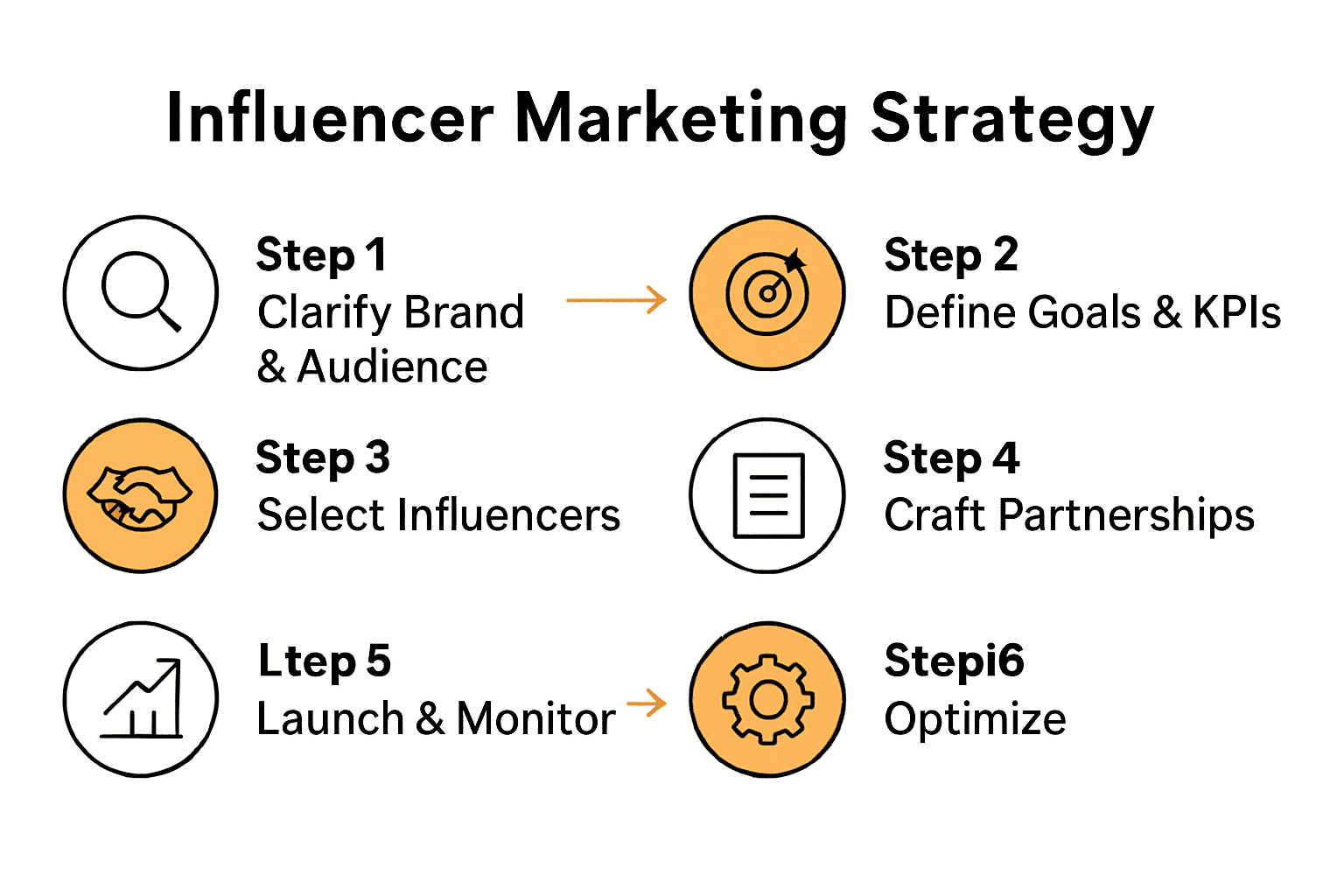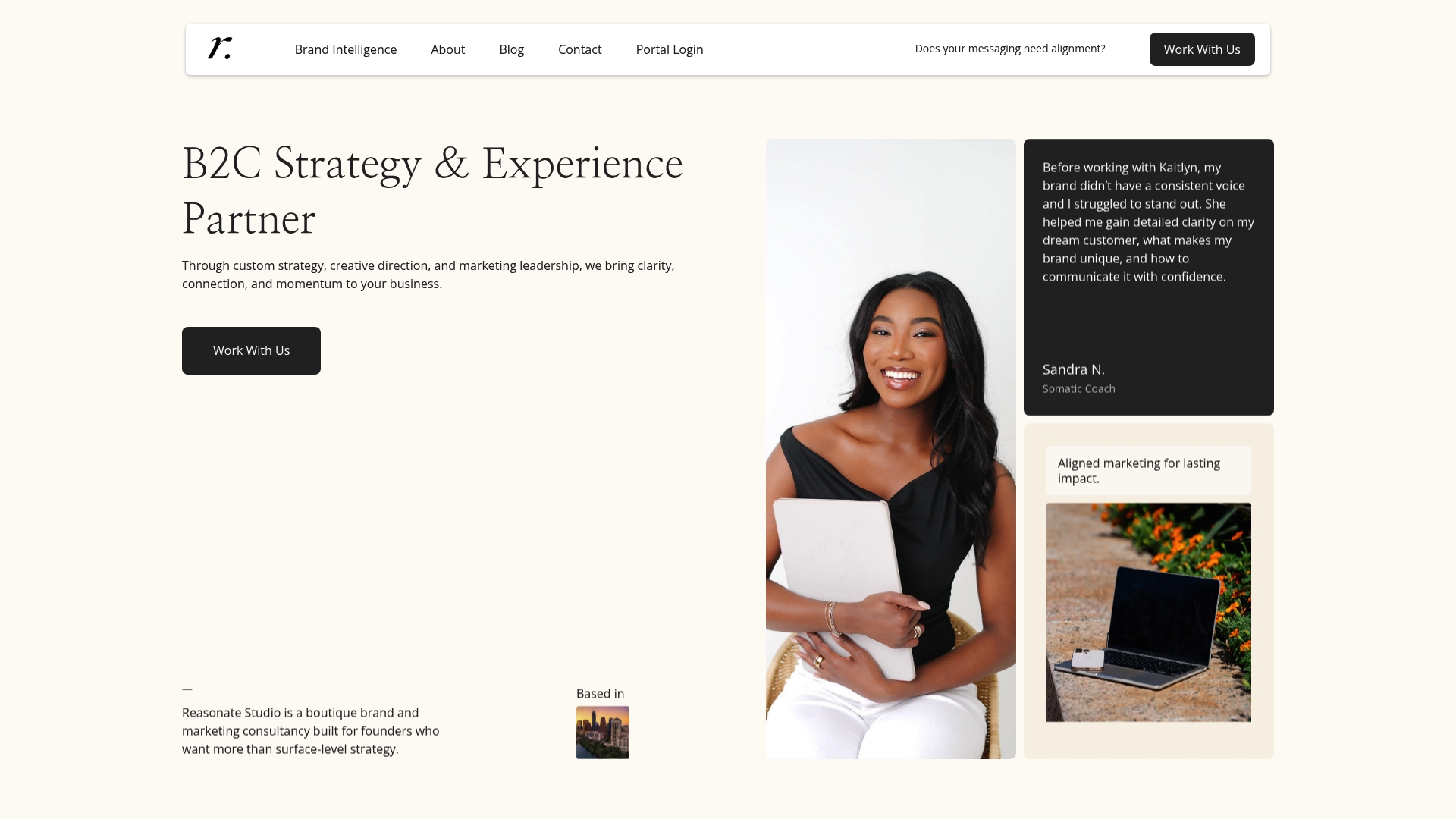Branding Strategies: Building Impactful Small Businesses

Learn how to create an influencer marketing strategy step by step, from audience targeting to campaign tracking, and achieve real business growth outcomes.

Over 86 percent of brands now use influencer marketing, yet only a fraction achieve real results. The secret is not just finding popular personalities, but truly connecting your brand with audiences who care. If you want to turn followers into loyal customers and campaigns into actual growth, it all starts with building a strategy on clarity, authentic partnerships, and data-backed decisions.
Before diving into influencer marketing, you need a crystal clear understanding of your brand identity and target audience. This foundational step transforms a scattered approach into a strategic powerhouse that converts followers into customers.
Start by documenting your brand’s core values, personality, and unique positioning. Who are you? What makes your brand different from competitors? These questions might seem simple, but they require deep introspection. Your brand foundations will serve as the north star for selecting influencers who genuinely align with your mission.
Research shows that 86% of brands are using influencer marketing, but credibility matters most. This means finding influencers who dont just have followers, but who can authentically represent your brand story. Create a detailed audience persona that goes beyond demographics. What are their aspirations? Pain points? Communication styles?
Map out specific characteristics that define your ideal customer. Consider factors like:
Pro Tip: Your audience persona should feel like a real person, not just a statistical profile.
Once you understand your brand and audience deeply, youll be positioned to select influencers who dont just have reach, but genuine resonance with your target market. This approach transforms influencer marketing from a numbers game into a strategic connection strategy.
In the next step, well explore how to identify and evaluate potential influencers who can truly amplify your brand message.
With your brand foundations clear, its time to set precise goals and measurable key performance indicators for your influencer marketing strategy. Think of this step as creating a strategic roadmap that transforms potential social media activity into tangible business outcomes.
Practical marketing frameworks suggest selecting one primary objective per campaign. Your goal could be increasing brand awareness, driving engagement, generating conversions, or creating high quality content. Each objective requires a different approach and specific metrics to track success.
Let’s break down potential campaign objectives with their corresponding KPIs:
Here’s a summary of key objectives and their recommended KPIs for influencer marketing campaigns:
| Objective | Recommended KPIs |
|---|---|
| Brand Awareness | Reach Impressions Audience Growth Video Views |
| Engagement | Likes Comments Shares Interaction Rate |
| Conversions | Click-Through Rate Website Traffic Direct Sales |
| Content Generation | Content Quality Brand Alignment Audience Feedback |
Research from marketing professionals emphasizes choosing metrics that directly demonstrate return on investment. This means moving beyond vanity metrics and focusing on outcomes that genuinely impact your business.
Pro Tip: Always tie your influencer marketing KPIs back to your overall business objectives.
Remember that each campaign might require a unique combination of goals. Be flexible and specific. A product launch might prioritize awareness and engagement, while a seasonal promotion could focus purely on conversions.
In the next step, well explore how to identify and select influencers who can help you achieve these precisely defined objectives.
With your goals and KPIs established, the next critical step is identifying influencers who can authentically represent your brand and deliver meaningful results. This isnt about chasing follower counts, but finding strategic partners who genuinely connect with your target audience.
Recent academic research highlights the importance of understanding social network dynamics when selecting influencers. Modern selection goes beyond surface level metrics and requires a nuanced approach that considers timing, reach, and authentic audience connection.
Start by developing a comprehensive influencer profile that matches your brands specific requirements. Look beyond raw follower numbers and evaluate key factors such as:
Practitioner guidance emphasizes using data driven methods to assess potential influencer partnerships. Use social listening tools and analytics platforms to gather insights about an influencers true reach and audience interaction patterns.
Pro Tip: An influencer with 10000 highly engaged followers can often deliver more value than someone with 100000 passive followers.
Dont just look at numbers look for storytellers who can genuinely integrate your brand message. The most effective influencers feel like trusted friends to their audience rather than walking billboards.
In the next step, well explore how to craft compelling collaboration proposals that turn potential influencer partnerships into strategic marketing opportunities.
With strategic influencers identified, your next move is creating partnership proposals that feel genuine and mutually beneficial. This step transforms potential connections into collaborative relationships that resonate with both your brand and the influencers audience.
Professional recommendations emphasize building long term partnerships that prioritize authentic storytelling over rigid corporate scripts. Your proposal should provide a clear framework while giving influencers creative breathing room to interpret your brand message through their unique voice.
When crafting your partnership proposal, focus on these key elements:
Best practices suggest developing a comprehensive yet flexible agreement that protects both parties while maintaining the influencers creative integrity. This means moving beyond transactional interactions and creating a collaborative environment where both brands and influencers feel valued.
Pro Tip: Position your proposal as a partnership opportunity not just a one time transaction.
Research indicates that the most successful influencer collaborations emerge from proposals that demonstrate genuine understanding of the influencers brand, audience, and content style. Show that youve done your homework and see them as a creative partner rather than just a marketing channel.

Remember that authenticity trumps perfection. Your goal is to create a proposal that feels like an exciting opportunity for collaboration not a restrictive contract.
In the next step, well explore how to develop compelling content strategies that leverage your new influencer partnerships.
With your authentic partnership proposals in place, its time to activate your influencer marketing campaign and implement a rigorous performance tracking strategy. This stage transforms your carefully crafted plans into measurable marketing actions.
Industry best practices emphasize using advanced platforms that enable real time performance tracking. Your monitoring approach should be comprehensive yet flexible, capturing multiple dimensions of campaign effectiveness beyond surface level metrics.
Set up a robust tracking system that captures critical performance indicators:
Experts recommend maintaining open communication channels with your influencer partners during the campaign. This allows for rapid iteration and strategic adjustments based on emerging performance trends. Think of this as a collaborative optimization process where both you and the influencer are actively improving campaign outcomes.
Pro Tip: Implement tracking links and unique promo codes for each influencer to precisely attribute performance.
Remember that initial campaign data provides valuable insights. Dont just collect numbers analyze them. Look for patterns in audience response, content styles that resonate, and unexpected engagement opportunities.
Quick and adaptive monitoring allows you to pivot strategies midcourse, maximizing your campaign effectiveness and return on investment. Treat each campaign as a learning opportunity that refines your future influencer marketing approach.
In the final step, well discuss how to evaluate campaign results and leverage insights for future marketing strategies.
After launching your influencer marketing campaign, the real magic happens in transforming raw performance data into strategic improvements. This final step is about turning insights into actionable optimization strategies that continuously elevate your marketing approach.
Comprehensive measurement frameworks suggest tracking your marketing funnel from initial awareness through complete conversion. This means looking beyond surface metrics and understanding the entire customer journey each influencer helps create.
Apply a systematic approach to data analysis:
Best practice research highlights the power of A/B testing different campaign variables. Experiment with content formats, messaging tones, call to action approaches, and platform selections to discover what truly resonates with your target audience.
Pro Tip: Treat each campaign as a learning laboratory not just a marketing execution.
Look for patterns that go beyond immediate campaign results. Which influencers created the most authentic connections? What content styles generated genuine audience interactions? These deeper insights will help you refine future partnership strategies.
Remember that optimization is an ongoing process. The most successful influencer marketing strategies are built on continuous learning, adaptation, and strategic refinement.
Your data driven approach transforms influencer marketing from a hit or miss tactic into a precise performance channel that delivers consistent results.

You put in the work clarifying brand foundations and carefully mapping out your audience. Still, most small businesses get stuck turning those insights into influencer campaigns that convert into real revenue. If you are tired of scattershot marketing and wasted budgets, you are not alone. The article outlined how crucial it is to anchor influencer marketing on clear strategy, measurable KPIs, and genuine partnerships. But too often, solo founders and small teams face overwhelm at every turn—setting goals, finding the right partners, or tracking what moves the needle.

This is where Reasonate Studio steps in. Our approach goes beyond surface tactics, blending systems thinking with creative storytelling through The Aligned Impact Model™. We help entrepreneurs set exact targets, handpick influencer partners that match your brand values, and build campaigns that bring lasting results—not just quick hits. Ready to stop guessing and create an influencer marketing strategy rooted in clarity and confidence? Start now at Reasonate Studio’s homepage and see how strategic guidance meets actionable support. Your next campaign can be the one that transforms your business. Book your first discovery call today.
To clarify your brand foundations, document your core values, personality, and unique positioning. Start by answering questions about what makes your brand different from competitors and describe your ideal customer using characteristics like age, interests, and purchasing motivations.
Set clear and measurable goals like increasing brand awareness, driving engagement, or generating conversions. For instance, if your goal is to boost brand awareness, track metrics like reach and impressions within the first 30 days of the campaign.
To select the right influencers, develop a profile that outlines audience demographics, engagement rates, and content quality that aligns with your brand. Focus on finding storytellers who resonate with your target audience rather than simply those with large follower counts.
Include transparent deliverable expectations, flexible creative guidelines, and a fair compensation structure in your proposal. Make sure to frame it as a collaborative opportunity that values the influencer’s unique voice and audience.
Effectively monitor your campaign by setting up a tracking system for key performance indicators like engagement rates and revenue generated. Use advanced analytics to capture performance trends and adjust your strategy based on what resonates with your audience.
To optimize future campaigns, analyze performance data and identify patterns in audience engagement and conversion rates. Implement A/B testing for different messaging styles and content formats, allowing you to refine your approach in subsequent campaigns.